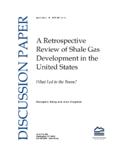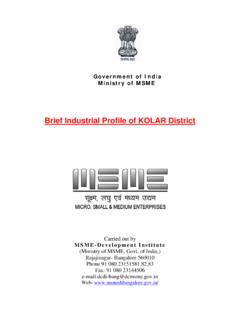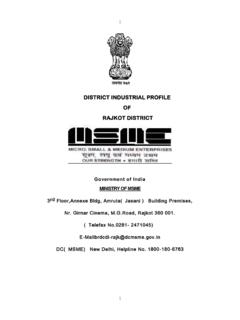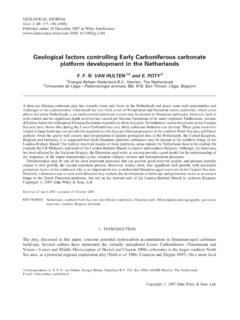Transcription of US Shale Gas Development - Resources for the Future
1 I S S U E B R I E F Date Issue brief # US Shale Gas Development What Led to the Boom? Zhongmin Wang and Alan Krupnick May 2013 Issue brief 13-04 2 [ A U T H O R S ] | R E S O U R C E S F O R T H E F U T U R E Resources for the Future Resources for the Future is an independent, nonpartisan think tank that, through its social science research, enables policymakers and stakeholders to make better, more informed decisions about energy, environmental, and natural resource issues. Located in Washington, DC, its research scope comprises programs in nations around the world. 1 W A N G A N D K R U P N I C K | R E S O U R C E S F O R T H E F U T U R E US Shale Gas Development What Led to the Boom? Zhongmin Wang and Alan Krupnick1 1. Introduction In this issue brief , we provide an overview of the economic, policy, and technology history of Shale gas Development in the United States to ascertain what led to the Shale gas boom.
2 For a much more detailed review, see our discussion paper (Wang and Krupnick 2013). In the past decade, Shale gas experienced an extraordinary boom in the United States, accounting for only percent of total US natural gas production in 2000, percent by 2005, and an astonishing percent by 2010. This remarkable growth has spurred interest in exploring for Shale gas Resources elsewhere. A number of countries, including China, Mexico, Argentina, Poland, India, and Australia are beginning to develop their own Shale gas Resources . Although it is difficult to know definitively the necessary or sufficient conditions for stoking a Shale gas boom, a historical review of the US experience can be informative. For a real boom to occur in the private sector, high profitability, or at least the expectation of Future high profitability, is a necessary ingredient. Our review suggests that a number of factors converged in the early 2000s.
3 1 Wang is a fellow and Krupnick is a senior fellow and director of the Center for Energy Economics and Policy at Resources for the Future . Key Points The Shale gas boom resulted from factors that ultimately enabled firms to produce Shale gas profitably, including technological innovation, government policy, private entrepreneurship, private land and mineral rights ownership, high natural gas prices in the 2000s, market structure, favorable geology, water availability, and natural gas pipeline infrastructure. The key question for policymakers in countries attempting to develop their own Shale gas Resources is how to generate a policy and market environment in which firms have the incentive to make investments and would eventually find it profitable to produce Shale gas. 2 W A N G A N D K R U P N I C K | R E S O U R C E S F O R T H E F U T U R E including high natural gas prices, favorable geology, private land and mineral rights ownership, market structure, water availability, and natural gas pipeline infrastructure to make it profitable to produce large quantities of Shale gas, but that the most important factor was innovations in technology.
4 Some of the key technological innovations resulted from government research and Development (R&D) programs and private entrepreneurship that aimed to develop unconventional natural gas, but other important technologies were largely developed by the oil industry for use in oil exploration and production. The seed of the Shale gas boom was planted in the late 1970s, when the US government aimed to encourage the Development of unconventional natural gas in response to the severe natural gas shortage at the time. Private firms lacked the incentive to make large, risky R&D investments, partly because it is difficult to keep new technologies proprietary in the oil and gas industry, where few technologies are patentable or licensable. Also, in the early years, unconventional gas sources could not compete with conventional oil or gas sources for investment dollars, and most US gas producers were small and did not have the incentive or capacity to do much R&D.
5 In response, the US government funded R&D programs and established tax credits (and incentive pricing) that stimulated the Development of Shale gas in the Appalachian and Michigan Basins and helped develop some key technologies, such as microseismic fracture (frac) mapping. It was, however, the private entrepreneurship of Mitchell Energy & Development (Mitchell Energy, hereafter) that played the primary role in developing the Barnett play in Texas, and it was the successful Development of the Barnett play that jump-started the Shale gas boom. Government-sponsored R&D programs did not target the Barnett play, and tax credits had a rather limited impact on Mitchell Energy. What Mitchell Energy had was the need and the financial capacity to develop the Barnett play. Later, the firm was also motivated by the potential to obtain large financial rewards from its innovations. The firm did this by leasing large tracts of land and the associated mineral rights at low prices and later selling the company including not only its leases but also its innovations and expertise at a higher price.
6 This strategy, which is made possible by the private land and mineral rights ownership system in the United States, overcomes the difficulty of monetizing technology innovations in the industry. We also note that, while environmental regulations of Shale gas Development are outside the scope of this issue brief , there was a significant effect of environmental lawsuits on Mitchell Energy and the implication that judicial enforcement of liability laws constrains firm behavior, even in the absence of environmental regulations specific to Shale gas Development . 2. What Led to the Government Policies on Unconventional Natural Gas? In the 1960s and 1970s, price ceilings on interstate natural gas were set at levels below the equilibrium prices that would arise in a competitive market. By stimulating demand and discouraging supply, these price ceiling resulted in shortages, first in natural gas reserves, and later in production. The shortage led to the passage of the Natural Gas Policy Act of 1978 (NGPA), 3 W A N G A N D K R U P N I C K | R E S O U R C E S F O R T H E F U T U R E which required phased removal of wellhead price controls and provided incentive pricing to encourage the Development of new natural gas, including from unconventional sources.
7 In response to the 1973 oil embargo and the subsequent energy crisis, the US government adopted a series of policies, including the consolidation and expansion of energy-related R&D programs, that ultimately led to the creation of the Department of Energy (DOE) to consolidate responsibilities for all federal energy policy and R&D programs. Federal spending on energy research significantly increased in the mid-1970s; for fossil energy programs, spending rose more than 10-fold between 1974 and 1979, from $143 million to $ billion (NETL 2010). Starting in the late 1970s, the US government adopted a series of specific policies to promote the Development of new sources of natural gas, which included incentive pricing, tax credits, R&D programs for unconventional natural gas, and policies promoting industry restructuring. INCENTIVE PRICING AND TAX CREDITS Section 107 of the NGPA provided for incentive pricing for Devonian(-age) Shale gas and other forms of unconventional natural gas with high extraction costs.
8 The deregulation of wellhead prices for natural gas from Devonian Shale and some other sources in 1979 created a huge advantage for these fledgling gas Resources . In the early 1980s, the deregulated high-cost natural gas was selling at more than twice the price of regulated natural gas. The 1979 oil crisis led to the passage in 1980 of the Crude Oil Windfall Profit Tax Act, part of which provided tax credits for producing unconventional fuels. This credit, implemented under Section 29 of the Internal Revenue Code, applied to unconventional gas from Devonian Shale , coal seams, and tight gas as well as some other fuels. The size of the tax credit for Devonian Shale (and coalbed methane) was determined by a formula that accounted for inflation and contained a factor that would gradually phase out the effect of the tax credit when the price of oil was high, such that the credits would take effect when oil prices were low enough to limit the competitiveness of unconventional fuels.
9 Gas producers had to select either NGPA incentive pricing or Section 29 tax credits. However, because prices of Devonian Shale and coalbed methane were deregulated in late 1979, producers naturally selected tax credits thereafter. As a result, Section 29 tax credits were far more important for the industry than incentive pricing. As we discuss in below, however, the tax credit and incentive pricing had limited impact on Mitchell Energy. R&D PROGRAMS The unconventional natural gas research program under DOE had three components: the Eastern Gas Shales Program, the Western Gas Sands Program, and the Methane Recovery from Coalbeds Program. Here we focus on the Eastern Gas Shales Program, the most pertinent program, and we discuss the relevant contributions of other DOE R&D programs. The role of the Gas Research 4 W A N G A N D K R U P N I C K | R E S O U R C E S F O R T H E F U T U R E Institute (GRI), which managed and funded R&D projects on natural gas, is discussed in our discussion paper (Wang and Krupnick 2013).
10 NRC (2001) assessed the most important energy-related technological innovations of the 1980s and the 1990s, which included three technologies that are critical to Shale gas Development : horizontal drilling, three-dimensional (3-D) seismic imaging, and fracturing technology. NRC (2001, 13) rated DOE s role in improving horizontal drilling and 3-D seismic imaging as absent or minimal, but rated DOE s role in fracture technology for tight gas as influential. Fracture technology for Shale gas was related to that for tight gas, which was developed earlier than Shale gas. Microseismic fracture mapping, another technology thought to be critical to Shale gas Development , was not yet fully developed or used at the time of the NRC report. Eastern Gas Shales Program NETL (2007, 19) indicates that DOE s Eastern Gas Shales Program helped unlock a major new .. source of significant natural gas supply. It revitalized gas shales drilling and Development in the Appalachian (Devonian) Basin, helped initiate Development of other previously over-looked gas Shale basins, and took the lead in demonstrating much more efficient and lower-cost gas Shale production and recovery technology.















